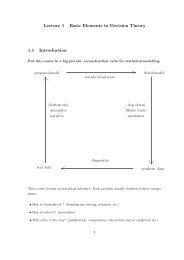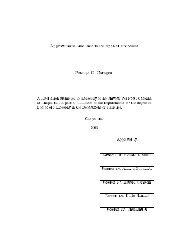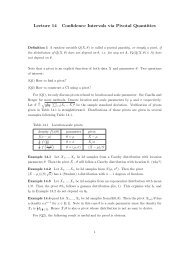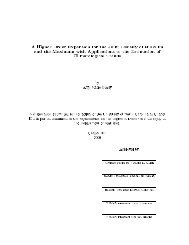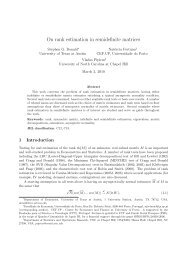Monte Carlo Methods in Statistical Mechanics: Foundations and ...
Monte Carlo Methods in Statistical Mechanics: Foundations and ...
Monte Carlo Methods in Statistical Mechanics: Foundations and ...
Create successful ePaper yourself
Turn your PDF publications into a flip-book with our unique Google optimized e-Paper software.
5 Multi-Grid Algorithms<br />
Thephenomenon of critical slow<strong>in</strong>g-down is not con ned to<strong>Monte</strong><strong>Carlo</strong> simulations:<br />
very similar di culties were encountered long agobynumerical analysts concerned<br />
with the numerical solution of partial di erential equations. An <strong>in</strong>genious solution,<br />
now called the multi-grid (MG) method, was proposed <strong>in</strong> 1964 by the Soviet numerical<br />
analyst Fedorenko [28]: the idea is to consider, <strong>in</strong> addition to the orig<strong>in</strong>al (\ ne-grid")<br />
problem, a sequence of auxiliary \coarse-grid" problems that approximate the behavior<br />
of the orig<strong>in</strong>al problem for excitations at successively longer length scales (a sort of<br />
\coarse-gra<strong>in</strong><strong>in</strong>g" procedure). The localupdates of the traditional algorithms are then<br />
supplemented by coarse-grid updates. To apresent-day physicist, this philosophy is<br />
remarkably rem<strong>in</strong>iscentoftherenormalization group | so it is all the more remarkable<br />
that itwas <strong>in</strong>vented two years before the work ofKadano [29] <strong>and</strong> seven years before<br />
the work ofWilson[30]!After a decade of dormancy, multi-grid was revived <strong>in</strong> the mid-<br />
1970's [31], <strong>and</strong> was shown to beanextremely e cient computational method. In the<br />
1980's, multi-grid methods have becomeanactive area of research<strong>in</strong>numerical analysis,<br />
<strong>and</strong> have been applied to awidevariety of problems <strong>in</strong> classical physics [32, 33]. Very<br />
recently [25] it was shown how astochastic generalization of the multi-grid method |<br />
multi-grid <strong>Monte</strong> <strong>Carlo</strong> (MGMC) | can be applied to problems <strong>in</strong> statistical, <strong>and</strong>hence<br />
also Euclidean quantum, physics.<br />
In this lecture we beg<strong>in</strong> by giv<strong>in</strong>g a brief <strong>in</strong>troduction to the determ<strong>in</strong>isticmulti-grid<br />
method we then expla<strong>in</strong> the stochastic analogue. 14 But itisworth <strong>in</strong>dicat<strong>in</strong>g nowthe<br />
basic idea beh<strong>in</strong>d this generalization. There is a strong analogy between solv<strong>in</strong>g lattice<br />
systems of equations (such asthediscrete Laplace equation) <strong>and</strong> mak<strong>in</strong>g <strong>Monte</strong> <strong>Carlo</strong><br />
simulations of lattice r<strong>and</strong>om elds. Indeed, given a Hamiltonian H('), thedeterm<strong>in</strong>istic<br />
problem is that ofm<strong>in</strong>imiz<strong>in</strong>g H('), while the stochastic problem is that ofgenerat<strong>in</strong>g<br />
r<strong>and</strong>om samples from the Boltzmann-Gibbs probability distribution e ; H(') . The<br />
statistical-mechanical problem reduces to the determ<strong>in</strong>istic one<strong>in</strong>thezero-temperature limit ! +1.<br />
Many (butnot all) of the determ<strong>in</strong>istic iterative algorithms for m<strong>in</strong>imiz<strong>in</strong>g H(')<br />
can be generalized to stochastic iterative algorithms | that is, dynamic <strong>Monte</strong> <strong>Carlo</strong><br />
methods | for generat<strong>in</strong>g r<strong>and</strong>om samples from e ; H(') .For example, the Gauss-Seidel<br />
; H<br />
algorithm for m<strong>in</strong>imiz<strong>in</strong>g H <strong>and</strong>theheat-bath algorithm for r<strong>and</strong>om sampl<strong>in</strong>g from e<br />
are very closely related. Both algorithms sweep successively through thelattice, work<strong>in</strong>g<br />
on one site x at atime. The Gauss-Seidel algorithm updates 'x so as to m<strong>in</strong>imize the<br />
Hamiltonian H(') =H('x f'ygy6=x) when all the other elds f'ygy6=x are held xed at<br />
their current values. The heat-bath algorithm gives 'x anew r<strong>and</strong>om value chosen from<br />
the probability distribution exp[;H('x f'ygy6=x)], with allthe elds f'ygy6=x aga<strong>in</strong><br />
held xed. As ! +1 the heat-bath algorithm approaches Gauss-Seidel. A similar<br />
correspondence holds between MG <strong>and</strong> MGMC.<br />
14 For an excellent <strong>in</strong>troduction to thedeterm<strong>in</strong>istic multi-grid method, see Briggs [34] more advanced<br />
topics are covered <strong>in</strong> the book of Hackbusch [32]. Both MG<strong>and</strong> MGMC are discussed <strong>in</strong> detail <strong>in</strong> [20].<br />
23



